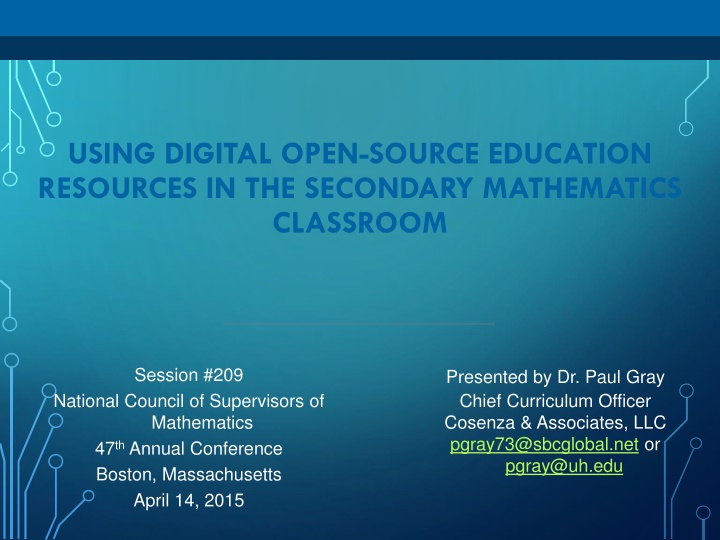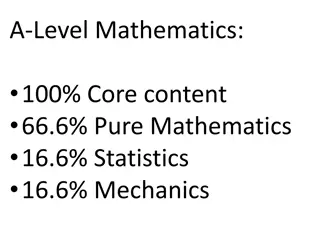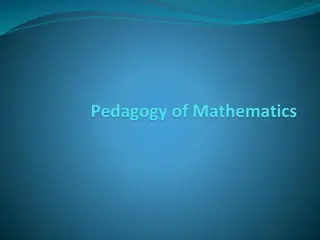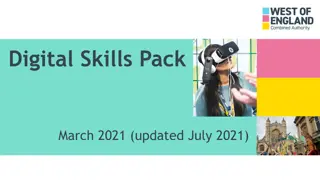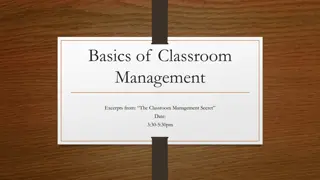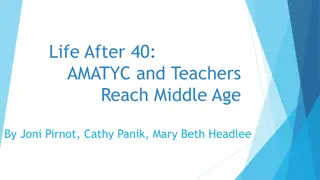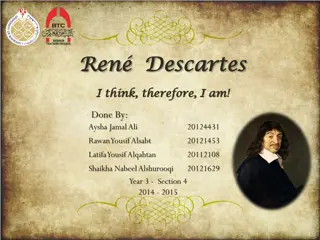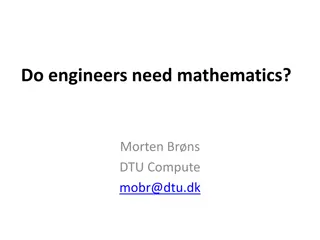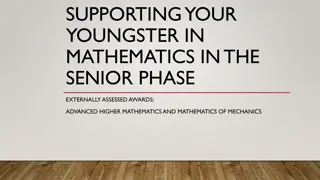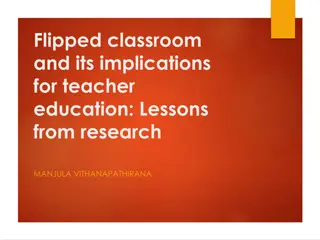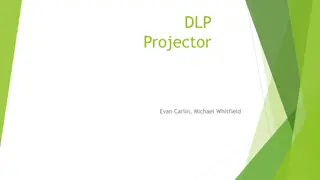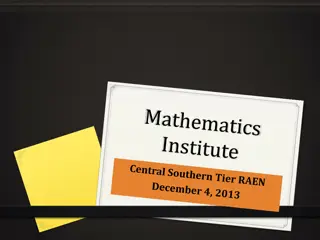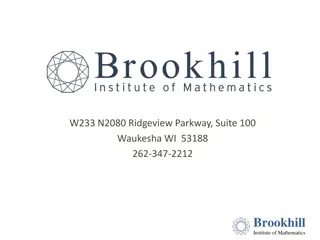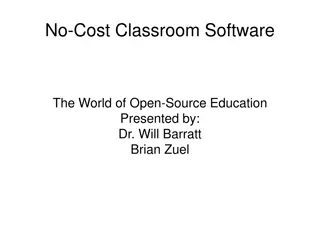Utilizing Digital Open-Source Education in Mathematics Classroom
In this session, Dr. Paul Gray presents strategies for incorporating open educational resources (OER) in secondary math education. The concept of a teacher as a curator is explored, emphasizing the importance of engaging students in meaningful mathematical tasks to enhance learning outcomes. The session delves into the theoretical framework, providing sample resources and practical strategies for building effective math lessons, ultimately aiming to empower educators to foster a deeper understanding of mathematics among students.
Download Presentation

Please find below an Image/Link to download the presentation.
The content on the website is provided AS IS for your information and personal use only. It may not be sold, licensed, or shared on other websites without obtaining consent from the author.If you encounter any issues during the download, it is possible that the publisher has removed the file from their server.
You are allowed to download the files provided on this website for personal or commercial use, subject to the condition that they are used lawfully. All files are the property of their respective owners.
The content on the website is provided AS IS for your information and personal use only. It may not be sold, licensed, or shared on other websites without obtaining consent from the author.
E N D
Presentation Transcript
USING DIGITAL OPEN-SOURCE EDUCATION RESOURCES IN THE SECONDARY MATHEMATICS CLASSROOM Session #209 Presented by Dr. Paul Gray Chief Curriculum Officer Cosenza & Associates, LLC pgray73@sbcglobal.net or pgray@uh.edu National Council of Supervisors of Mathematics 47th Annual Conference Boston, Massachusetts April 14, 2015
SESSION OVERVIEW Theoretical Framework Sample Resources for Open Educational Resources (OER) Strategies for Building a Lesson 2
WHAT IS A CURATOR? The core task of a curator remains working with objects - acquiring, researching, storing and interpreting them for the public (Museums Association). The curator is in charge of developing, safeguarding, studying, and publicizing the collection in his or her care (The Louvre). 3
TEACHER AS CURATOR A curator knows art, collects it, cares for it, and delights in sharing it with others, helping them see it in ways they may not have discovered if left on their own. We choose this term for teachers who do these things with literature, opening this way of knowing the world to their students. (Eeds & Peterson, 1991, p. 118) Teachers should go beyond transactional learning to help students develop insight into the content (Eeds & Peterson, 1991) Practice your own reading Practice writing with students Listen carefully to students as they talk about a book Trust the books, trust the students, and trust yourself 4
THATS NICE, BUT WHAT ABOUT THE MATH? Mathematics is a complex and beautiful body of knowledge as well as a complex way of knowing. Mathematical experiences are like literature students glean meaning and understanding from the mathematical tasks we pose to them. 5
AND SPEAKING OF TASKS All tasks are not created equal different tasks require different levels and kinds of student thinking. (Stein, Smith, Henningsen, & Silver, 2009) Mathematical tasks are a set of problems or a single complex problem the purpose of which is to focus students attention on a particular mathematical idea. (Briars, 2011) Mathematical tasks are essential to students opportunities to learn mathematics what it is and how to do it and influence learning by directing attention to aspects of content and ways to process the information (Briars, 2011). 6
AND SPEAKING OF TASKS Effective teaching of mathematics engages students in solving and discussing tasks that promote mathematical reasoning and problem solving and allow multiple entry points and varied solution strategies. Principles to Action, 2014, p. 17 7
HOW MATH LEADERS CAN HELP To ensure that instructional materials create excitement and motivation, are developmentally appropriate, and support high-quality lessons: Provide access to rich instructional resources; Guide the selection of instructional resources; Involve teachers in the selection of instructional resources It s TIME: A Leadership Framework for Common Core Mathematics, 2014, p. 33 8
OPEN EDUCATION RESOURCES http://tube.geogebra.org Interactive sketches for geometry and pictorial models http://projectsharetexas.org Standard-specific (Texas TEKS) aligned instructional resources http://nlvm.usu.edu/en/nav/vli brary.html http://maine.edc.org/file.ph p/1/oer/math_OERforMath. html Clearinghouse for OER http://phet.colorado.edu/en /simulations/category/math Interactive simulations http://illuminations.nctm.org Mobile-based and Java-based interactives by topic and grade band Library of interactive, Java-based virtual manipulatives
CURATING A LEARNING EXPERIENCE 5E lesson design Engage Explore Explain Elaborate Evaluate Three-Act Tasks Inquiry Lesson Design Other experience-based lesson framework 11
POSSIBLE LESSON FRAMEWORK Lesson Stage Student/Teacher Activity Resources Introduction Content Exploration Content Formalization Application 12
PAUSE AND REFLECT How can these lesson components be integrated into a coherent learning experience? How do digital tasks support high-quality student learning? How can OER provide tasks that promote mathematical reasoning and problem solving and allow multiple entry points and varied solution strategies (P2A)? 13
REFERENCES Eeds, M., & R. Peterson. (1991, October). Teacher as curator: Learning to talk about literature. The Reading Teacher 45(2), pp. 118-126. Stein, M. K., et al. (2009). Implementing standards-based mathematics instruction: A casebook for professional development. 2nd ed. New York: Teachers College Press. Briars, D. J. (2011). High-leverage actions for mathematics education leaders. Symposium conducted at the NCTM 2011 Annual Meeting & Exposition, Indianapolis, IN. National Council of Supervisors of Mathematics. (2014). It s TIME: A leadership framework for Common Core mathematics. Bloomington, IN: Solution Tree Press. 14 National Council of Teachers of Mathematics. (2014). Principles to action: Ensuring mathematical success for all. Reston, VA: NCTM.
QUESTIONS, COMMENTS, OR SUCCESS STORIES? Dr. Paul Gray pgray73@sbcglobal.net pgray@uh.edu PowerPoint available on www.cosenzaassociates.com (Events and Conferences section) 15
